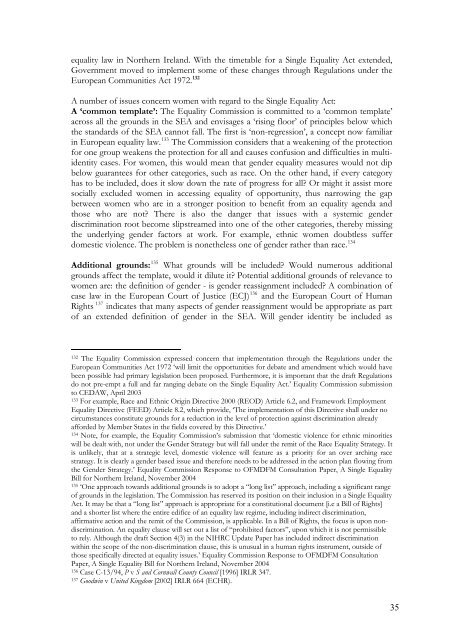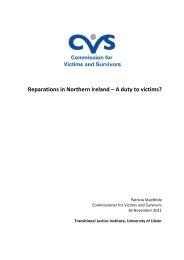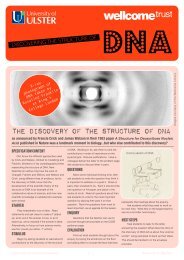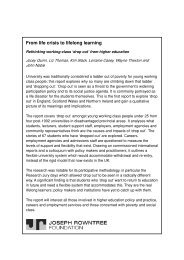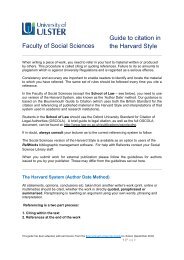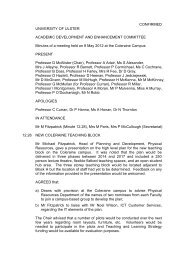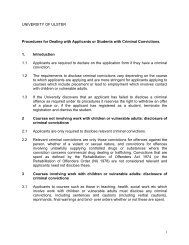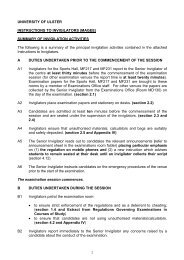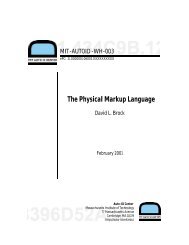Agreement Reached in the Multi-Party Negotiations - Transitional ...
Agreement Reached in the Multi-Party Negotiations - Transitional ...
Agreement Reached in the Multi-Party Negotiations - Transitional ...
Create successful ePaper yourself
Turn your PDF publications into a flip-book with our unique Google optimized e-Paper software.
equality law <strong>in</strong> Nor<strong>the</strong>rn Ireland. With <strong>the</strong> timetable for a S<strong>in</strong>gle Equality Act extended,<br />
Government moved to implement some of <strong>the</strong>se changes through Regulations under <strong>the</strong><br />
European Communities Act 1972. 132<br />
A number of issues concern women with regard to <strong>the</strong> S<strong>in</strong>gle Equality Act:<br />
A ‘common template’: The Equality Commission is committed to a ‘common template’<br />
across all <strong>the</strong> grounds <strong>in</strong> <strong>the</strong> SEA and envisages a ‘ris<strong>in</strong>g floor’ of pr<strong>in</strong>ciples below which<br />
<strong>the</strong> standards of <strong>the</strong> SEA cannot fall. The first is ‘non-regression’, a concept now familiar<br />
<strong>in</strong> European equality law. 133 The Commission considers that a weaken<strong>in</strong>g of <strong>the</strong> protection<br />
for one group weakens <strong>the</strong> protection for all and causes confusion and difficulties <strong>in</strong> multiidentity<br />
cases. For women, this would mean that gender equality measures would not dip<br />
below guarantees for o<strong>the</strong>r categories, such as race. On <strong>the</strong> o<strong>the</strong>r hand, if every category<br />
has to be <strong>in</strong>cluded, does it slow down <strong>the</strong> rate of progress for all? Or might it assist more<br />
socially excluded women <strong>in</strong> access<strong>in</strong>g equality of opportunity, thus narrow<strong>in</strong>g <strong>the</strong> gap<br />
between women who are <strong>in</strong> a stronger position to benefit from an equality agenda and<br />
those who are not? There is also <strong>the</strong> danger that issues with a systemic gender<br />
discrim<strong>in</strong>ation root become slipstreamed <strong>in</strong>to one of <strong>the</strong> o<strong>the</strong>r categories, <strong>the</strong>reby miss<strong>in</strong>g<br />
<strong>the</strong> underly<strong>in</strong>g gender factors at work. For example, ethnic women doubtless suffer<br />
domestic violence. The problem is none<strong>the</strong>less one of gender ra<strong>the</strong>r than race. 134<br />
Additional grounds: 135 What grounds will be <strong>in</strong>cluded? Would numerous additional<br />
grounds affect <strong>the</strong> template, would it dilute it? Potential additional grounds of relevance to<br />
women are: <strong>the</strong> def<strong>in</strong>ition of gender - is gender reassignment <strong>in</strong>cluded? A comb<strong>in</strong>ation of<br />
case law <strong>in</strong> <strong>the</strong> European Court of Justice (ECJ) 136 and <strong>the</strong> European Court of Human<br />
Rights 137 <strong>in</strong>dicates that many aspects of gender reassignment would be appropriate as part<br />
of an extended def<strong>in</strong>ition of gender <strong>in</strong> <strong>the</strong> SEA. Will gender identity be <strong>in</strong>cluded as<br />
132 The Equality Commission expressed concern that implementation through <strong>the</strong> Regulations under <strong>the</strong><br />
European Communities Act 1972 ‘will limit <strong>the</strong> opportunities for debate and amendment which would have<br />
been possible had primary legislation been proposed. Fur<strong>the</strong>rmore, it is important that <strong>the</strong> draft Regulations<br />
do not pre-empt a full and far rang<strong>in</strong>g debate on <strong>the</strong> S<strong>in</strong>gle Equality Act.’ Equality Commission submission<br />
to CEDAW, April 2003<br />
133 For example, Race and Ethnic Orig<strong>in</strong> Directive 2000 (REOD) Article 6.2, and Framework Employment<br />
Equality Directive (FEED) Article 8.2, which provide, ‘The implementation of this Directive shall under no<br />
circumstances constitute grounds for a reduction <strong>in</strong> <strong>the</strong> level of protection aga<strong>in</strong>st discrim<strong>in</strong>ation already<br />
afforded by Member States <strong>in</strong> <strong>the</strong> fields covered by this Directive.’<br />
134 Note, for example, <strong>the</strong> Equality Commission’s submission that ‘domestic violence for ethnic m<strong>in</strong>orities<br />
will be dealt with, not under <strong>the</strong> Gender Strategy but will fall under <strong>the</strong> remit of <strong>the</strong> Race Equality Strategy. It<br />
is unlikely, that at a strategic level, domestic violence will feature as a priority for an over arch<strong>in</strong>g race<br />
strategy. It is clearly a gender based issue and <strong>the</strong>refore needs to be addressed <strong>in</strong> <strong>the</strong> action plan flow<strong>in</strong>g from<br />
<strong>the</strong> Gender Strategy.’ Equality Commission Response to OFMDFM Consultation Paper, A S<strong>in</strong>gle Equality<br />
Bill for Nor<strong>the</strong>rn Ireland, November 2004<br />
135 ‘One approach towards additional grounds is to adopt a “long list” approach, <strong>in</strong>clud<strong>in</strong>g a significant range<br />
of grounds <strong>in</strong> <strong>the</strong> legislation. The Commission has reserved its position on <strong>the</strong>ir <strong>in</strong>clusion <strong>in</strong> a S<strong>in</strong>gle Equality<br />
Act. It may be that a “long list” approach is appropriate for a constitutional document [i.e a Bill of Rights]<br />
and a shorter list where <strong>the</strong> entire edifice of an equality law regime, <strong>in</strong>clud<strong>in</strong>g <strong>in</strong>direct discrim<strong>in</strong>ation,<br />
affirmative action and <strong>the</strong> remit of <strong>the</strong> Commission, is applicable. In a Bill of Rights, <strong>the</strong> focus is upon nondiscrim<strong>in</strong>ation.<br />
An equality clause will set out a list of “prohibited factors”, upon which it is not permissible<br />
to rely. Although <strong>the</strong> draft Section 4(3) <strong>in</strong> <strong>the</strong> NIHRC Update Paper has <strong>in</strong>cluded <strong>in</strong>direct discrim<strong>in</strong>ation<br />
with<strong>in</strong> <strong>the</strong> scope of <strong>the</strong> non-discrim<strong>in</strong>ation clause, this is unusual <strong>in</strong> a human rights <strong>in</strong>strument, outside of<br />
those specifically directed at equality issues.’ Equality Commission Response to OFMDFM Consultation<br />
Paper, A S<strong>in</strong>gle Equality Bill for Nor<strong>the</strong>rn Ireland, November 2004<br />
136 Case C-13/94, P v S and Cornwall County Council [1996] IRLR 347.<br />
137 Goodw<strong>in</strong> v United K<strong>in</strong>gdom [2002] IRLR 664 (ECHR).<br />
35


